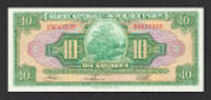The island of Hispaniola was discovered by Christopher Columbus in 1492. The western part of the island was evacuated by the Spanish in 1605 and became a French colony in 1664. The island of Hispaniola was divided between French Saint Dominique (Haiti) and Spanish Santo Domingo (Dominican Republic) on September 20, 1697. When Haiti gained its independence on January 1, 1804, two independent political Haitian entities existed, and one in the north of the island and one in the south. The two were merged into a single State on October 8, 1820. The Dominican Republic was originally part of Haiti, but it became independent of Haiti on February 27, 1844.
The French Colonial Livre (XFCL) coins, Spanish silver Escudos (XESE), Portuguese gold Joes and British Pound Sterling (GBP) were used according to whoever was in control of Saint Dominique at any one point in time. The Piaster Gourde (HTT) was used in the 1700s and 1800s, and was equal to a Mexican Piastre or 8 Livres Coloniales, 5 Sols.
Toussaint Louverture issued the first coins for Haiti in 1804, although there had been counterstamping of coins between 1781 and 1809. The first coins were issued by independent Haiti by President, later King, Henri Christophe in 1807. Although the coins were decimal, they were issued in denominations of 6, 12 and 25 centimes. The Silver Gourde (HTS) replaced the Piastre Gourde on June 30, 1814, and the paper Gourde (HTP) was introduced on September 25, 1826. The paper Gourde steadily depreciated and by 1869 it took 4000 Paper Gourdes to obtain 1 US Dollar. A new Gourde (HTN), equal to 10 paper Gourdes was introduced in 1870, but it also depreciated quickly. The Haitian Gourde (HTG) was introduced on August 26, 1872 to replace the New Gourde at the rate of 300 New Gourdes equal to 1 Gourde. The Gourde was set at par to the US Dollar, and on September 28, 1880, the Gourde went on the Gold Standard and was set equal to 5 French Francs. The exchange rate was reset at 1 U.S. Dollar to 5 Gourdes on September 16, 1915. The Gourde is divisible into 100 Centimes.
The Treasury of the Republic of Haiti issued banknotes from 1827 until 1916. The Banque Nationale d'Haiti issued banknotes in 1875. In 1910, the Banque Nationale de la Republique d'Haiti was established. It was controlled by the Banque d'Union Parisienne and then by the National City Bank of New York. Haiti regained control over the National Bank in 1935. It has issued banknotes since 1916.


